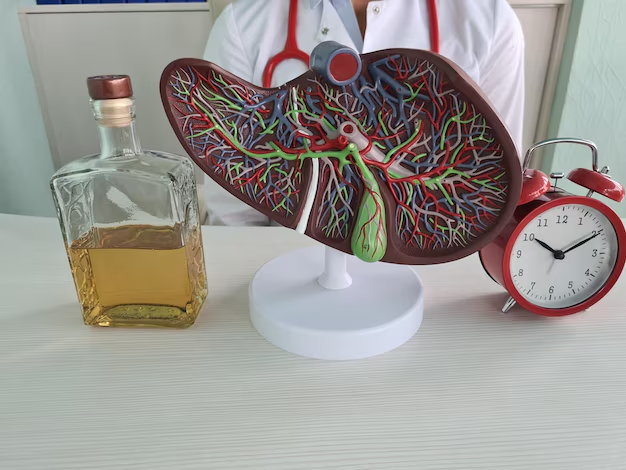- Home
- About Us
- Services
- Treatments
- Acid Reflux
- Allergic Rhinitis
- Alcoholic Fatty Liver
- Ankylosing Spondylitis
- Anxiety / Stress
- Arthritis
- Asthma
- Cervical Spondylitis
- Celiac Infection
- Colitis
- Constipation
- Dermatitis
- Detox Programme
- Diabetes (Madhumeha)
- Hair Fall
- Headache
- Hormonal Imbalance
- Hypertension
- Insomnia
- Irritable Bowel Syndrome
- Lungs Disease
- Migraine
- Neurological Disorder
- Non Alcoholic Fatty Liver
- Obesity Management
- Pain Management
- PCOD
- PCOS
- Sciatica Pain
- Sinusitis
- Skin Disorder
- Slip Disc
- Stress Management
- Thyroid
- Weight Management
- Techno-Ayurveda
- Media
- Blog
- Contact Us

Alcoholic Fatty Liver
Understanding Alcoholic Fatty Liver
AFLD occurs when fat accumulates in the liver cells due to chronic alcohol intake. The liver becomes overwhelmed by the alcohol and begins to store excess fat. Early stages of AFLD typically don’t show symptoms, but if the condition worsens, it can lead to:
- Fatigue
- Abdominal pain
- Jaundice (yellowing of the skin and eyes)
- Weight loss
- Nausea
- Enlarged liver (hepatomegaly)
In Ayurveda, the liver is considered an important organ for the metabolism of Pitta dosha (heat, transformation) and the processing of toxins or Ama. Excessive alcohol consumption leads to an imbalance in the Pitta dosha, causing heat and toxins (Ama) to accumulate in the liver and digestive system. This leads to inflammation, congestion, and the buildup of fat in the liver.
Symptoms of Alcoholic Fatty Liver
1. Fatigue
2. Weakness
3. Pain or discomfort in the upper right abdomen
4. Enlarged Liver
5. Jaundice (yellowing of the skin and eyes)
6. Loss of appetite
7. Nausea
8. Swelling in the abdomen
9. Confusion and difficulty concentrating
10. Unexplained weight loss
11. Vomiting
Common Causes of Alcoholic Fatty Liver

Panchakarma Ayurvedic Treatment for Alcoholic Fatty Liver
Alcoholic fatty liver disease (AFLD) is a condition in which excessive alcohol consumption leads to fat accumulation in liver cells. It is often the first stage of alcohol-related liver disease, which can progress to more severe conditions such as alcoholic hepatitis, cirrhosis, or liver failure if left untreated. The liver plays a crucial role in detoxifying the body and metabolizing nutrients, so when it becomes impaired, it can lead to a variety of health issues. Ayurvedic treatments, particularly Panchakarma therapy, offer a holistic approach to addressing alcoholic fatty liver disease by detoxifying the body, rejuvenating liver function, and promoting overall healing.
How Panchakarma Helps in Alcoholic Fatty Liver
Panchakarma is a detoxification and rejuvenation process used in Ayurveda to cleanse the body of accumulated toxins (Ama), balance the doshas, and restore overall health. It includes a series of therapies that are designed to purify and rejuvenate the body, strengthen the digestive fire (Agni), and reduce the harmful effects of toxins on the liver.
For treating alcoholic fatty liver, Panchakarma works on two main levels:
- Detoxification and elimination of Ama (toxins): Alcohol consumption and its toxic metabolites cause Ama accumulation in the liver and throughout the body. Panchakarma therapies help remove these toxins, reducing the burden on the liver and promoting healing.
- Balancing Pitta and restoring liver function: Since alcohol aggravates Pitta dosha, the therapies aim to pacify Pitta and restore proper function to the liver, improving its ability to metabolize and process nutrients and toxins.
Dietary Recommendations for Alcoholic Fatty Liver
In Ayurveda, diet plays a crucial role in managing liver health. The following dietary guidelines can help improve liver function and prevent further damage:
- Avoid alcohol and other substances that burden the liver.
- Consume light, easily digestible foods such as soups, rice, and vegetables to reduce the load on the liver.
- Include bitter and astringent foods like leafy greens, cucumbers, and fenugreek to reduce excess Pitta and promote detoxification.
- Drink herbal teas like turmeric tea, cumin-coriander-fennel (CCF) tea, or dandelion root tea, which promote liver health and digestion.
- Eat small, frequent meals to avoid overloading the digestive system and support the liver’s detoxification process.
- Limit oily, fried, and processed foods that increase the accumulation of toxins and fat in the liver.
FAQs of Alcoholic Fatty Liver
Alcoholic fatty liver is the accumulation of fat in liver cells due to excessive alcohol consumption, often leading to liver inflammation and potential progression to more severe liver disease.
Excessive alcohol consumption overwhelms the liver, causing fat to build up in liver cells. Factors like genetics, diet, and duration of alcohol use also contribute to the condition.
Early symptoms may include fatigue, abdominal discomfort, and mild jaundice. Many people have no symptoms initially, and the condition is often detected during routine medical exams.
Diagnosis involves blood tests to assess liver function, imaging (like ultrasound), and sometimes a liver biopsy to confirm fat accumulation and rule out other liver diseases.
